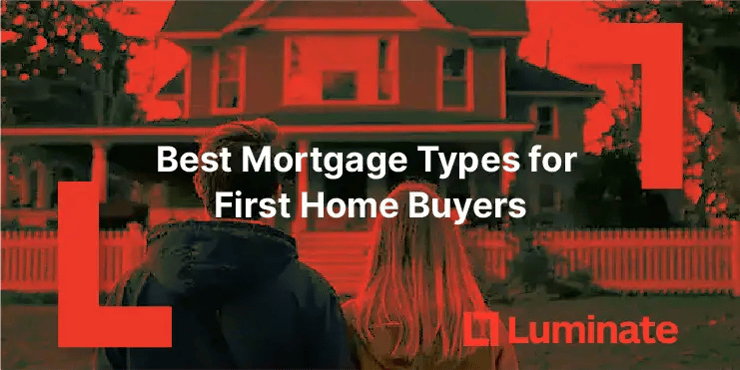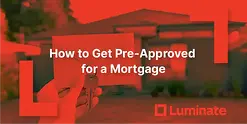Best Mortgage Types for First Home Buyers NZ 2025 | Complete Guide
 By
Trent Bradley
·
9 minute read
By
Trent Bradley
·
9 minute read

Quick Answer: Most first-home buyers in New Zealand choose a combination of fixed-rate (70-80%) and floating-rate (20-30%) mortgages. This structure provides payment certainty while allowing flexibility for extra repayments, helping you pay off your loan faster without penalty.
Table of Contents
- Understanding Your First Home Loan Options in NZ
- Fixed Rate Mortgages for First Home Buyers
- Floating (Variable) Rate Mortgages
- Revolving Credit Mortgages
- Offset Mortgages
- Table Loans (Principal and Interest)
- Interest-Only Mortgages
- Mortgage Comparison Table
- Which Mortgage Type Is Right for First Home Buyers?
- First Home Buyer Support in New Zealand
- How Luminate Helps First Home Buyers
- Final Thoughts: Choosing Your First Home Loan
- Frequently Asked Questions
Key Takeaways
- Most first-home buyers choose a split structure with 70-80% fixed rate for stability and 20-30% floating for repayment flexibility
- Fixed rates provide payment certainty for budgeting, while floating rates allow unlimited extra repayments without penalties
- Revolving credit and offset mortgages suit disciplined savers who actively manage finances to reduce interest costs
- Table loans (principal and interest) are the standard structure for first-home buyers to build equity steadily over time
- Government schemes like First Home Loan and KiwiSaver HomeStart Grant can help reduce deposit requirements
- Most first-home buyers fix for 1-2 years to balance interest rate certainty with flexibility to refinance
If you're buying your first home in New Zealand, you've probably already discovered that mortgages aren't one-size-fits-all. Between fixed rates, floating rates, revolving credit, table loans, and interest-only options, it can all feel a bit overwhelming.
Choosing the right type of mortgage is one of the most important financial decisions you'll make as a first-home buyer. It affects your repayments, your flexibility, and how much interest you'll pay over time. The good news is you don't have to navigate this alone.
At Luminate Financial Group, we help first-home buyers across Auckland, Wellington, Christchurch, and throughout New Zealand structure their home loans in a way that suits their goals, income, and lifestyle. In this guide, we break down the main mortgage types and help you understand what might work best for your situation.
Understanding Your First Home Loan Options in NZ
Before diving into specific mortgage types, it's worth knowing that New Zealand first-home buyers have access to government support schemes like the First Home Loan (requiring only 5% deposit) and KiwiSaver HomeStart Grant (up to $10,000 for existing homes). Your mortgage structure should work alongside these benefits to maximize your purchasing power.
Fixed Rate Mortgages for First Home Buyers
This is the most common type of home loan for first-home buyers in New Zealand. With a fixed rate mortgage, your interest rate and repayments stay the same for a set period — usually between six months and five years.
Pros
- Certainty and stability: You know exactly what your repayments will be, which makes budgeting easier
- Protection from rate rises: You're protected from increasing interest rates during the fixed term
- Peace of mind: Ideal for tight budgets in the early years of home ownership
Cons
- No benefit from rate drops: If interest rates fall, you're locked into a higher rate until your fixed term ends
- Break fees apply: There can be significant costs if you want to make large lump-sum repayments or refinance early
- Less flexibility: Limited ability to make extra repayments during the fixed period
When it works best
Fixed rates are ideal if you value certainty and want to keep your repayments consistent, especially in the early years of home ownership when your budget might be tight. In the current New Zealand market, many first-home buyers fix for 1-2 years to balance stability with flexibility.
Floating (Variable) Rate Mortgages
A floating rate mortgage means your interest rate can go up or down at any time, depending on the market and your lender's pricing.
Pros
- Maximum flexibility: You can make extra repayments without penalty, repay your loan early, or refinance more easily
- Benefit from rate drops: If rates fall, your repayments may decrease automatically
- No break fees: Freedom to restructure your loan whenever needed
Cons
- Rate rise risk: If rates increase, your repayments go up too
- Harder to budget: Variable payments can make financial planning more difficult
- Potential stress: Unexpected rate rises can create financial pressure if you haven't built in a buffer
When it works best
Floating loans suit buyers who want flexibility to pay their mortgage off faster or who expect interest rates to drop. Many first-home buyers in New Zealand combine a small floating portion (20-30%) with a larger fixed loan to allow some repayment flexibility while maintaining stability.
Revolving Credit Mortgages
A revolving credit mortgage works like a large overdraft. Your income is paid directly into the loan account, and you use it as your main transaction account. Interest is charged daily on the outstanding balance.
Pros
- Faster debt reduction: If you manage your spending carefully, you can reduce the average daily balance and pay off your loan faster
- Complete flexibility: Full repayment flexibility and easy access to surplus funds
- Interest savings: Every dollar in your account reduces the interest you pay
Cons
- Requires discipline: If you tend to spend everything that's available, you might not reduce your loan at all
- Harder to track: Can be difficult to monitor progress unless you're closely watching your balance
- Higher interest rates: Usually priced slightly higher than standard fixed or floating rates
When it works best
Revolving credit works for first-home buyers with strong budgeting habits, stable income, and a goal of paying down their loan quickly. It's often used alongside a fixed or floating loan, not on its own.
Offset Mortgages
An offset mortgage is similar to revolving credit, but instead of one account, your savings and transaction account balances are offset against your mortgage balance. You only pay interest on the difference.
Pros
- Interest savings: You reduce the interest charged on your mortgage without locking money away
- Maintain access: Flexibility to access your savings while still benefiting from interest reductions
- Great for savers: Rewards those who maintain healthy account balances
Cons
- Limited availability: Not all lenders offer offset accounts in New Zealand
- Need meaningful balances: You need to keep substantial balances in your savings to make it worthwhile
- Complexity: Can be harder to understand than standard mortgages
When it works best
Offset mortgages suit first-home buyers who consistently maintain savings or cash buffers and want interest savings without restricting access to their money.
Table Loans (Principal and Interest)
This is the standard structure for most mortgages in New Zealand. With a table loan, you make regular repayments that cover both interest and principal over time. At the end of the term, the loan is fully paid off.
Pros
- Builds equity steadily: Your debt reduces consistently over time
- Predictable timeline: Structured to repay the full loan by the end of the term, usually 25 to 30 years
- Responsible lending: Aligns with New Zealand's Credit Contracts and Consumer Finance Act (CCCFA) requirements
Cons
- Higher initial payments: Repayments are usually higher at the start than interest-only loans
- Less cash flow flexibility: Less money available for other expenses in the early years
When it works best
This is the go-to structure for first-home buyers in New Zealand. It helps build equity steadily and ensures you're making real progress on home ownership from day one.
Interest-Only Mortgages
With an interest-only mortgage, you only pay the interest on your loan for a set period (typically one to five years). Your repayments are lower, but the loan balance doesn't reduce.
Pros
- Lower short-term payments: Reduced repayments can help with cash flow
- Renovation flexibility: Useful if you're doing major renovations in the first year
- Variable income friendly: Can help self-employed first-home buyers manage irregular income
Cons
- No equity building: You aren't paying off the loan principal unless property values increase
- Payment shock: Once the interest-only period ends, repayments increase significantly
- Higher long-term costs: You'll pay more interest over the life of the loan
When it works best
Interest-only loans are more common with property investors than first-home buyers. However, they may suit some buyers in unique situations, such as self-employed borrowers with irregular income or buyers planning major renovations in year one.
Mortgage Comparison Table
| Mortgage Type | Best For | Flexibility | Risk Level | Typical Use |
|---|---|---|---|---|
| Fixed Rate | Budget certainty | Low | Low | 70-80% of loan |
| Floating Rate | Extra repayments | High | Medium | 20-30% of loan |
| Revolving Credit | Disciplined savers | Very High | Medium | Small portion |
| Offset | High savers | High | Low | Supplementary |
| Table Loan | Building equity | Medium | Low | Standard structure |
| Interest-Only | Short-term relief | Low | High | Rare for first buyers |
Which Mortgage Type Is Right for First Home Buyers?
There's no single right answer. The best mortgage structure for your first home loan depends on your goals, income stability, risk tolerance, and lifestyle.
The most common approach: Most first-home buyers in New Zealand choose a mix of fixed and floating to balance stability and flexibility. For example, you might fix 70-80% of your loan for one to two years and keep 20-30% on a floating rate so you can make extra repayments or reduce debt faster.
This split structure gives you:
- Predictable payments on the majority of your loan
- Freedom to make lump-sum payments when you have extra cash
- The ability to pay your mortgage off faster without penalties
- Protection if interest rates rise significantly
Real Example Scenario
Sarah and James, first-home buyers in Wellington:
- Purchase price: $750,000
- Deposit: $150,000 (20%)
- Loan amount: $600,000
- Structure: $450,000 fixed at 6.5% for 2 years, $150,000 floating at 7.0%
This gives them stable payments while allowing them to put Sarah's annual bonus toward the floating portion without penalty, potentially saving thousands in interest.
First Home Buyer Support in New Zealand
When structuring your mortgage, consider how government schemes can help:
First Home Loan: Eligible buyers can purchase with just a 5% deposit through approved lenders. Income and purchase price caps apply.
KiwiSaver HomeStart Grant: First-home buyers may receive up to $5,000 per person ($10,000 for couples) for existing homes, or $10,000 per person for new builds.
First Home Partner: Allows the government to take an equity stake in your property, reducing your mortgage size.
Your mortgage adviser should help you understand which schemes you qualify for and how to structure your loan accordingly.
How Luminate Helps First Home Buyers
At Luminate, we tailor every home loan structure to your situation. We look at your goals over the next one, three, and five years and recommend a setup that supports your financial wellbeing without unnecessary restrictions or risk.
We help first-home buyers across New Zealand:
- Navigate government first-home buyer schemes
- Compare rates from multiple lenders
- Structure loans for maximum flexibility and savings
- Understand the true costs beyond just interest rates
- Plan for future life changes (kids, job changes, renovations)
Final Thoughts: Choosing Your First Home Loan
Understanding the different mortgage types helps you make smarter decisions about your first home loan in New Zealand. Whether you're after stability, flexibility, or a mix of both, choosing the right structure from day one can save you thousands over the life of your loan.
This isn't a decision to make based on headlines or your mate's advice. Talk to an experienced mortgage adviser who understands the full picture and who can walk you through your options based on current New Zealand market conditions.
Ready to find the best mortgage structure for your first home?
Book a free First-Home Mortgage Session with Luminate. We'll assess your goals, explain your options in plain language, and help you lock in the right loan structure for your first home.
📞 Call 0800 333 400
📧 Email askus@luminate.co.nz
🌐 Visit luminate.co.nz
Luminate Financial Group - helping first-home buyers in Auckland, Wellington, Christchurch, and across New Zealand achieve home ownership since 2008.
Frequently Asked Questions (FAQs)
What is the most common mortgage type for first home buyers in NZ?
Most first-home buyers in New Zealand choose a combination structure with 70-80% fixed rate for payment stability and 20-30% floating rate for repayment flexibility. This split approach balances predictable monthly payments with the ability to make extra repayments without penalties, helping you pay off your mortgage faster.
Should I choose fixed or floating for my first mortgage?
Neither fixed nor floating alone is ideal for most first-home buyers. A split structure gives you the best of both worlds: fixed rate provides certainty for budgeting, while floating allows penalty-free extra repayments. Your exact split should depend on your income stability, risk tolerance, and financial goals.
How much deposit do I need as a first home buyer in New Zealand?
While a 20% deposit is standard to avoid low equity fees and margins, first-home buyers in New Zealand can access government schemes that allow smaller deposits. The First Home Loan scheme enables eligible buyers to purchase with just 5% deposit. You can also use your KiwiSaver for your deposit, provided you leave at least $1,000 in your account.
Can I change my mortgage type after I've already fixed it?
Yes, when your fixed rate term ends, you can completely restructure your mortgage without penalty. During a fixed term, making changes may incur break fees which can be substantial. This is why many advisers recommend starting with a split structure and choosing shorter fixed terms of 1-2 years to maintain flexibility.
What happens if interest rates drop after I fix my mortgage?
If you've fixed your mortgage and rates drop, you remain locked into your fixed rate until the term expires. Breaking a fixed rate early typically incurs significant break fees. However, if you have a split structure, your floating portion will automatically benefit from any rate decreases. You can refinance the fixed portion to a lower rate when it comes up for renewal.
How do I know if I need a revolving credit or offset mortgage?
Revolving credit and offset mortgages suit first-home buyers who are disciplined with money, maintain healthy savings, and want to actively manage their mortgage to save interest. If you have strong budgeting habits and regularly have surplus income, these products can save you thousands. However, if you tend to spend what's available or find detailed budgeting challenging, stick with a standard fixed/floating split structure.
What's the difference between principal and interest vs interest-only mortgages?
Principal and interest repayments (also called table loans) reduce your loan balance with each payment, building equity in your home over time. Interest-only payments only cover the interest cost, so your loan balance stays the same. First-home buyers should almost always choose principal and interest to build equity and home ownership. Interest-only is typically used by property investors or in specific short-term situations.
What government help is available for first home buyers in New Zealand?
First-home buyers in New Zealand can access several government schemes: the First Home Loan (allowing purchase with just 5% deposit through approved lenders), the KiwiSaver HomeStart Grant (up to $5,000 per person for existing homes or $10,000 for new builds), and the First Home Partner scheme (where the government takes an equity stake to reduce your mortgage). Eligibility depends on income limits, purchase price caps, and whether you've owned property before.
How long should I fix my mortgage for as a first home buyer?
Most first-home buyers in New Zealand fix for 1-2 years as this provides a good balance between interest rate certainty and flexibility. Shorter terms let you refinance more frequently to take advantage of better rates or change your structure as your circumstances evolve. Longer terms of 3-5 years offer more stability but less flexibility. Consider fixing different portions for different terms to create a laddered structure.
Can I make extra repayments on my mortgage?
Yes, but it depends on your mortgage type. Floating rate mortgages allow unlimited extra repayments without penalty. Fixed rate mortgages typically allow limited extra repayments (often up to $10,000-$30,000 per year) before break fees apply. Revolving credit and offset mortgages offer complete flexibility. This is why many first-home buyers keep 20-30% of their loan on floating to make extra payments when they have surplus cash.

Trent Bradley
Trent Bradley is a New Zealand financial advisor specializing in property-backed finance and investment consulting. With over 26 years of experience running his mortgage broking business, he has helped wholesale investors access high-yield property-backed loan opportunities. For the past 12 years, Trent has led Luminate Finance, a New Zealand finance company dedicated to connecting investors with secure property investment solutions.























